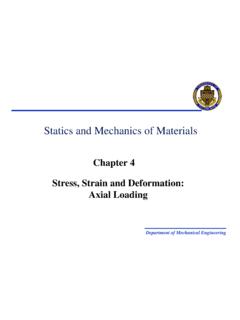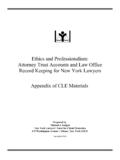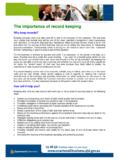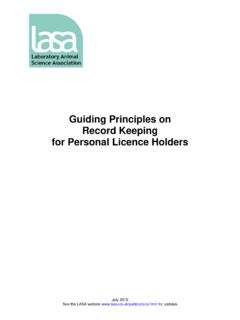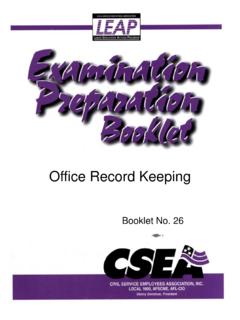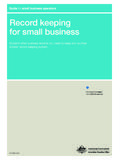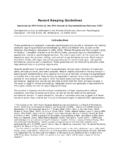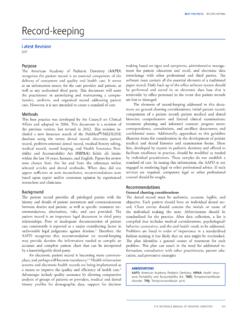Transcription of 7 INTRODUCTION TO THE Keeping student records ACCESS …
1 Lesson 7: INTRODUCTION to the ACCESS Database 193 7 INTRODUCTION TO THE ACCESS DATABASE Keeping student records LEARNING OUTCOMES In this tutorial you will learn about databases in general and about the ACCESS database in particular. The concept of a database is not as easy to grasp as that of a word processor or a spreadsheet. So if this is the first time you are learning about databases you would be well advised to read over the lesson first, away from the computer, and perhaps highlight the text to ease understanding. Specifically this tutorial will introduce you to the following: the general idea behind a database planning a new database creating a database template adding records to a new or existing database viewing the data in a database clearing entries and records from a database making a backup copy of a database A caveat before you begin: You'll find it easiest to use the tutorial if you follow the directions carefully.
2 On computers there are always other ways of doing things, but if you wander off on your own be sure you know your way back! ESSENTIAL MICROSOFT OFFICE XP: Tutorial for Teachers Copyright Bernard Poole, Lorrie Jackson, Rebecca Randall, 2002. All rights reserved 194 AN OVERVIEW OF THE DATABASE CONCEPT The database component of MS Office is designed to act as an "intelligent"1 electronic filing cabinet. Like a manual filing cabinet, it enables you to collect sets of related data and keep the data organized; update the data once you've collected them, by adding or deleting records and by changing existing records ; An electronic filing cabinet such as a database allows you also to easily and quickly use the data--sort them, create reports, merge the data with other documents, and so forth. How is a database organized? ACCESS is an object-oriented relational database management system.
3 The objects that make up any particular database that you create using ACCESS are illustrated in Fig. Fig. The ACCESS database objects 1 The word "intelligent" is enclosed in quotes so as not to create a false impression. With regard to computers, the word is overused, and strictly speaking inappropriate. It also can be misleading. The only "intelligence" exhibited by these otherwise "dumb" machines has been programmed into them by intelligent human beings. Lesson 7: INTRODUCTION to the ACCESS Database 195 A Table is an object which represents the data in rows and columns, rather like a spreadsheet. For this reason, when you view a table in an ACCESS database, you are in what ACCESS refers to as a Datasheet View. You will learn about Tables in this lesson. A Query is an object which makes a request to the database to find some set of data that is stored in the database.
4 You will learn about queries in Lesson 8. A Form is an object which gives the user another view of the data in the database. Whereas a Table allows the user to view multiples records at once, a Form displays the contents of just one record at a time. You will learn about Forms in this lesson, too. A Report is an object which is designed based on the data in the database and which is used to inform the user of the selected contents of the database. You will learn about reports in Lesson 8. A Page is a special type of web page designed for viewing and working with data from the Internet. This ACCESS feature is beyond the scope of these tutorials. A Macro is a sequence of instructions which can be carried out with a single click of the mouse button on a button in a toolbar or by pressing a key or combination of keys on the keyboard. You may recall developing a Word macro in Lesson 6.
5 Finally, a Module is a collection of programming procedures designed to give programmer control over the ACCESS database look and feel. A reminder of the general terminology for secondary storage of data Words are our stepping stones to knowledge. Personal computers today, for the most part, still use electronic disks as the medium for the secondary storage of data. The Windows computer operating system, like most operating systems, organizes data hierarchically on the disk using documents and directories. Documents are usually stored in directories or subdirectories that are part of the overall directory file management system. Within documents, different terminology is used to describe the organization of data depending on the type of document in question. Word processed documents tend to organize data in paragraphs and sentences; spreadsheet documents organize the data in rows and columns; database documents organize the data into records and fields.
6 The ACCESS database terminology in particular An ACCESS database is able to contain thousands of records ; records contain fields; each field contains the raw data called entries made up of characters which are the basic building blocks of data. For example, let us say you have given a student an assignment to study birds and to build a database to store the data collected. The student decides to set up a record for each bird sighted. Each record will include field names ( ACCESS database field names may be up to 63 characters long) such as Common Name of bird, type (Family) of bird, Size, Habitat, etc. A field name such as Common Name of bird might contain the entry "seagull", for example. A database thus contains records ; records have fields; the fields contain entries. These entries are made accessible by the Data View (Table), Form, and Report functions of the ACCESS database.
7 At the end of the year, for example, the student would be able to write a relatively ESSENTIAL MICROSOFT OFFICE XP: Tutorial for Teachers Copyright Bernard Poole, Lorrie Jackson, Rebecca Randall, 2002. All rights reserved 196 sophisticated report using the word processor, merge into the report the data collected in the database, and even add illustrations of the birds. It will be useful for you at this stage to see an actual ACCESS database on the computer. Put your Work Disk in the disk drive, then open the Office Database Management program called ACCESS In the New File Task Pane (Fig. ), under Open a file, click on More Fig. The New File Task Pane ACCESS will display the Open dialog box. Make sure the drive with your ACCESS Disk in it is the active drive, then double click to open the database document named Birds ( ) Showing the Full menus and organizing the Toolbars In case you're using a computer in a lab or some computer other than your own, you should set the options to Always show full menus, Show the Standard and formatting toolbars on two rows, List font names in their own font, and Show ScreenTips on toolbars.
8 You may recall doing this at the beginning of all the previous lessons. If the computer you're using doesn't already have these settings, here's what you do. Lesson 7: INTRODUCTION to the ACCESS Database 197In the Tools menu, select , and in the dialog box that pops up, select the Options tab (Fig. ) Fig. The Customize dialog box Make sure there is a check mark next to the item to Always show full menus While you're at it, check the box next to Show Standard and Formatting toolbars on two rows, List font names in their font, and Show ScreenTips on toolbars Click the Close button when you're ready ACCESS displays a dialog box (Fig. ) prompting you to decide how you want to view the data on the screen. Fig. How do you want to view the data in the database? Each of the Objects listed in the menu on the left side of the Database dialog box represent one of the objects of the ACCESS object-oriented database management system.
9 You can view the data either as a form, record by record, as illustrated in Fig. ESSENTIAL MICROSOFT OFFICE XP: Tutorial for Teachers Copyright Bernard Poole, Lorrie Jackson, Rebecca Randall, 2002. All rights reserved 198 Fig. The Form View of the database This Forms view gives you a view of the records one by one. On the other hand, you can view the data as a Table, where the data is displayed in columns or as a list (Fig. ). Fig. records listed in Table View Make sure the Tables Object button is selected on the Birds Database dialog box and the BirdSightings table highlighted, then click on the Open button in the Birds database toolbar (or just double click on BirdSightings) In the top left corner of the window, in the Title bar, you see the Table name (BirdSightings). In the bottom left corner of the Form and Table View windows are tools to ACCESS specific records in the database.
10 Lesson 7: INTRODUCTION to the ACCESS Database 199 Fig. illustrates what each of these navigation tools does. Fig. Navigation tools in the ACCESS database As you can see there are 50 records in the database. The field names (Common Name, Family, Size, etc.) are at the top of each column of data. As you can see, the screen is not big enough to allow you simultaneously to see all the records in the Birds database. If you want to scroll through the records or look at any specific record, you have several options: You can use the scroll bar on the right of the screen to scroll through the records . Try this now To move one by one through the records , you can click left or right on the arrows in the ACCESS control tools in the lower left corner of the window. Try this now To go directly to a specific record, you can select the number of the record you want to view by typing the number of that record in the small data entry box between the arrows.

